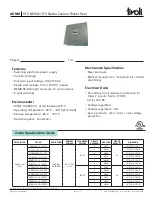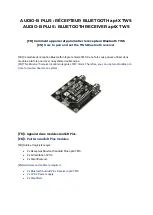
INSTALLATION INSTRUCTION 83
DP 6000 DIGITAL PAGING SYSTEM
Page 11/29
February 1997.
ADDRESS PROGRAMMING VIA THE PROGRAMMING
KEYBOARD OF LBB 5840 TELEPHONE COUPLER:
First individual address, press
C/CCC0/1/A/A3/A2/A1/A0 (to program address 1)
Second individual address, press
C/CCC0/0/A/A3/A2/A1/A0 (to program address 0)
First group address, press
C/CCC0/2/A/A3/A2/A1/A0 (to program address 2)
Second group address, press
C/CCC0/3/A/A3/A2/A1/A0 (to program address 3)
Third group address, press
C/CCC0/4/A/A3/A2/A1/A0 (to program address 4)
Fourth address, press
C/CCC0/5/A/A3/A2/A1/A0 (to program address 5)
Fifth group address, press
C/CCC0/6/A/A3/A2/A1/A0 (to program address 6)
After each address has been programmed the transceiver will
bleep and the numeric display will show:
A A3A2A1A0
3.1.2 PROGRAM AN OPERATION CODE
To program the functions into the transceiver, 6-different
operation codes are used. Each operation code consists of 6
Hex digits and each digit determines one or a group of func-
tions.
An operation code can be programmed with the following sys-
tem calls:
■
CCC M PQRSTU
M = 6 if operation code 1 is programmed in the transceiver
M = 7 if operation code 2 is programmed in the transceiver
M = 8 if operation code 3 is programmed in the transceiver
M = 9 if operation code 4 is programmed in the transceiver
M = A if operation code 5 is programmed in the transceiver
M = B if operation code 6 is programmed in the transceiver
When the PC Alpha Desk software is used to program the
transceiver’s opcodes, these system calls are generated auto-
matically. Note that even when using the Alpha Desk software,
opcode 1 must be programmed as code 6, etc..
Each digit of the operation code is represented by the letters P,
Q, R, S, T, U, and the function or group of functions assigned
to each digit is as follows (for a more in-depth description of
the opcodes, refer to Chapter 3.4):
OPCODE 1
P
=
Receiver status
Q =
Speech status
R
=
System identity
S
=
No. of address digits to be displayed
T
=
Speech time
U =
RSSI - level
OPCODE 2
P
=
Personal bleep pattern 1 on/off rhythm
Q =
“
“
“
“
“
R
=
Personal bleep pattern 1 frequency selection
S
=
“
“
“
“
“
T
=
Pilot tone 1 frequency selection
U =
Auto talk-back time
OPCODE 3
P
=
Personal bleep pattern 2 on/off rhythm
Q =
“
“
“
“
“
R
=
Personal bleep pattern 2 frequency selection
S
=
“
“
“
“
“
T
=
Pilot tone 2 frequency selection
U =
Codeinf digit for manual acknowledge in ‘old system
mode’.
OPCODE 4
P
=
Indication status
Q =
User program sign status
R
=
User program enable status
S
=
Alarm status
T
=
Alarm enable status
U =
Options
OPCODE 5
P
=
Fast move level setting
Q =
Turn on time no-move/angle alarm
R
=
Turn-on time fast move
S
=
Pre-alarm time no-move/angle alarm
T
=
Pre-alarm time fast move
U =
Pre-alarm time tear-off
OPCODE 6
P
=
Fast charge time (steps of 15 minutes)
Q =
Power off enable/disable
R
=
not used
S
=
not used
T
=
not used
U =
not used












































